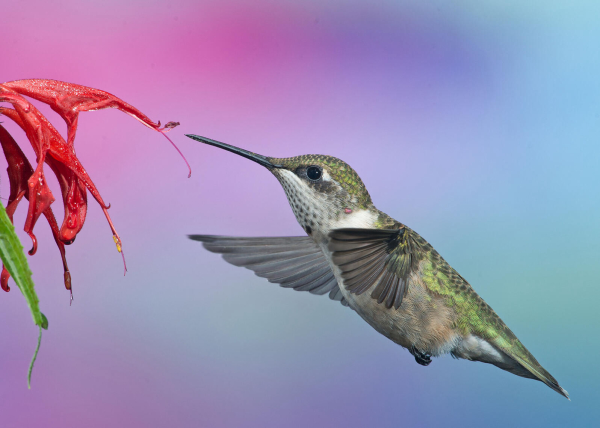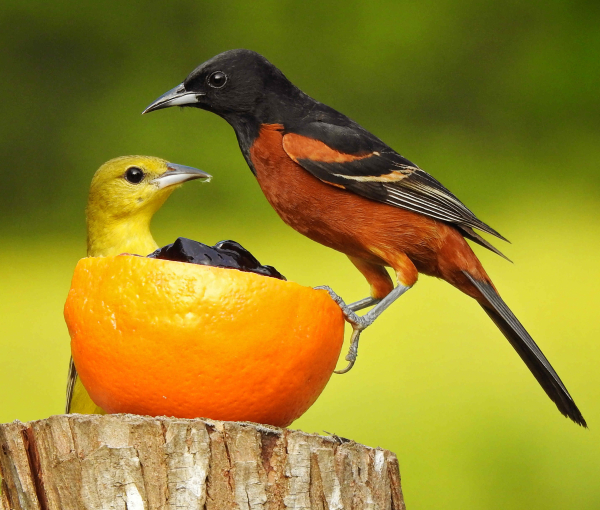
A variety of hummingbirds are headed north; watch for returning Ruby-throated Hummingbirds as well as western species (photo by Andy Streufert).

A pair of Orchard Orioles is attracted to a half-orange filled with grape jelly (photo by Pam Carcia).
|
They are on the way! Some of the favorite birds that visit our feeding stations are beginning their annual spring migration northward – are you ready for them? It’s go time to clean your favorite nectar and fruit feeders, and stock up on the foods that will bring hummingbirds and orioles to our window views. It’s easy to attract these beautiful and remarkable birds, and we provide a great benefit to the birds that have traveled from tropical wintering areas. By offering a couple simple foods, it’s very easy to reap the rewards of having hummingbirds and orioles in your yard, out your window, and in your landscaping.
Some will be making a pit stop before continuing their race northward, while others may be at the end of their journey and will begin preparing for the rigors of the nesting season. You may even be able to entice some birds into spending the spring and summer in your neighborhood by providing all the right stuff, in the form of foods and fresh water.
Nectar – Everyone knows that hummingbirds will visit a simple sugar-water feeder. Orioles like sugar-water nectar too. You can buy pre-mixed sugar-water for hummingbirds and orioles, which is simple enough. Or you can mix your own using 1 part white sugar to 4 parts fresh water – then mix it well, add it to your hummingbird feeder; position your feeder where you can best watch the action. The reasoning behind this sugar-water mix is that it is closest to the sugar content produced by flowers preferred by hummingbirds, orioles, and other nectar-feeding birds.
Hummingbird Feeders – The best thing about hummingbird feeders is that there is an abundance of feeders to fit every birder’s tastes, personality, and pocketbook. For a couple dollars you can get a simple hummingbird feeder, which is all you need to try to attract hummingbirds. But we all appreciate the chance to add a little pizazz to our yard or feeding station, and there are plenty of options on the market to choose from. Remember though, hummingbirds are most attracted to the color red, because red flowers tend to have the best nectar - that’s why many feeders feature red color. You may also choose to add a second feeder if you get lots of action at your primary feeder, but it’s best to position a second feeder a distance away to reduce competition between territorial hummingbirds.
Oriole Feeders – Some orioles are attracted to sugar-water nectar too, but most birders prefer to provide a separate feeder for orioles, which are obviously larger birds that usually need a larger opening to feed from. Orioles are also partial to orange color – and oranges – so most oriole nectar feeders tend to be orange in color to attract orioles. They also have larger feeding ports, and some even have places where you can offer 3 foods at once – sugar-water, sliced oranges, and grape jelly – which is a great option because, as stated above, not all orioles feed at nectar feeders.
Oriole Jelly & Oranges – The best food to offer to attract orioles initially is sliced oranges, but the absolute favorite food of orioles is grape jelly. Orioles are attracted to the color orange, and to the fruit of oranges, at least initially. We have found that their interest in oranges wanes after an initial week or so, but they can’t get enough grape jelly throughout the spring and summer seasons. The easiest way to provide grape jelly is to buy it in convenient squeeze bottles that make it easy to squeeze jelly into a small bowl, or whatever space a feeder might provide. Oranges are usually offered cut in halves, and its best to “nail” them into position. Better yet, there are special oriole feeders that lack nectar vessels, but have a small bowl (for jelly) and a couple spikes (for orange halves) that serve orioles very well.
Flowers and Landscaping – As spring and summer progress, you previous gardening and landscaping efforts will attract a variety of birds. Now is a great time to plant a flower garden for hummingbirds, emphasizing tubular red flowers are the best to attract hummingbirds. You can also add a few planters or potted plants to your homescape that will be appreciated by hummers. Orioles and hummingbirds will also react to flowering trees and shrubs in your yard, part of your landscaping efforts in past years. But it’s not too late to add an oriole and hummingbird magnet to your yard: A quick trip to your local nursery will provide many options for you to plant, including young but maturing trees and shrubs that will flower soon and provide fruits during late summer and fall.
Bugs – Both hummingbirds and orioles get their protein by eating small insects, caterpillars, and spiders, so they will help to keep bugs in check around your home, along with a variety of songbirds and flycatchers.
Water – All birds appreciate a fresh water source, which can be as simple as a shallow basin filled with water, or a bird bath positioned in your yard. Both these options can be improved by adding a dripper, mister, mini-fountain, or another option to keep water moving, which is a big attraction for birds searching for a water source. Any other type of water feature will be welcomed too, as long as it has a shallow area where small birds can drink and bathe.
Enjoy the northbound migration of hummingbirds into southern, central, and northern states and southern Canada, along with the advances of orioles by providing the foods they prefer, and you will eventually be rewarded for your efforts. Past years of experience make veteran birders long for the first sights of hummingbirds at their nectar feeder and flower garden, and the prospect of orioles feeding on oranges and jelly while gleaning nectar and insects from flowering trees and shrubs is a high point in yards across the continent. It’s an exciting time of year – be prepared, and enjoy every moment!
Share your backyard birding experiences and photos at editorstbw2@gmail.com